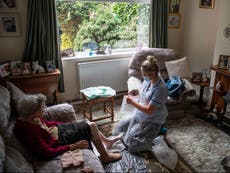Coronavirus: Nearly 2 million more people to be told they are ‘high risk’
New model doubles the number of patients advised to shield and takes into consideration factors from ethnicity to postcode
Your support helps us to tell the story
From reproductive rights to climate change to Big Tech, The Independent is on the ground when the story is developing. Whether it's investigating the financials of Elon Musk's pro-Trump PAC or producing our latest documentary, 'The A Word', which shines a light on the American women fighting for reproductive rights, we know how important it is to parse out the facts from the messaging.
At such a critical moment in US history, we need reporters on the ground. Your donation allows us to keep sending journalists to speak to both sides of the story.
The Independent is trusted by Americans across the entire political spectrum. And unlike many other quality news outlets, we choose not to lock Americans out of our reporting and analysis with paywalls. We believe quality journalism should be available to everyone, paid for by those who can afford it.
Your support makes all the difference.Nearly two million people across England are to be told for the first time that they are at greater risk from coronavirus and should consider shielding at home.
In total, 1.7 million people will be offered the chance to join the list of clinically vulnerable patients shielding at home, almost doubling the list from 2.3 million to 4 million. It will mean around 820,000 adults between 19 and 69 will be prioritised for vaccination.
They have been designated at higher risk under a new predictive risk model following an analysis of the medical records of more than 8 million people and the characteristics of patients who died or suffered severe infections during the first wave of the pandemic last year.
The model has been developed by experts at the University of Oxford at the request of the chief medical officer Chris Whitty and adopted by the Department of Health and Social Care and NHS England. It is thought to be the first time any model has been used like this anywhere in the world.
Patients will be encouraged to start shielding at home and offered the chance to receive the extra support available to those patients including food deliveries and access to statutory sick pay.
Follow live: All Covid updates from the UK today.
Dr Jenny Harries, deputy chief medical officer for England, said: “For the first time, we are able to go even further in protecting the most vulnerable in our communities.
“The model’s data-driven approach to medical risk assessment will help the NHS identify further individuals who may be at high risk from Covid-19 due to a combination of personal and health factors.
“This action ensures those most vulnerable to Covid-19 can benefit from both the protection that vaccines provide, and from enhanced advice, including shielding and support, if they choose it.”
All of the people identified have not had an individual clinical condition previously classed as high risk. They have now been selected due to a number of personal risk factors and underlying health conditions.
The model has been developed because of concerns not all patients at risk from the virus were being identified. To give a weighted cumulative risk, the new model combines factors including underlying conditions, age, sex, ethnicity, body mass index and the postcode where people live and its link with deprivation.
Patients will receive letters giving them advice and their GPs will be notified, meaning anyone who has not already been vaccinated may be put to the top of the list.
The University of Oxford tool, called QCovid, has been validated by the Office for National Statistics and the Medicines and Healthcare products Regulatory Agency. The research to develop the model will be published in the British Medical Journal with the university planning to make the code available within a month.
Lead researcher Professor Julia Hippisley-Cox, a GP and professor of clinical epidemiology at Oxford, said: “The QCovid model, which has been developed using anonymised data from more than 8 million adults, provides nuanced assessment of risk by taking into account a number of different factors that are cumulatively used to estimate risk including ethnicity.
“I’m delighted that less than a year after being funded by the National Institute for Health Research, the model is now being used to help protect people at most risk from Covid-19.”
The tool can be used for people aged between 19 and 100 and may help prioritise some patients including those with learning disabilities who are thought to be up to three times more likely to die from Covid-19. Adults with Down’s Syndrome have been added to the shielding list due to a higher risk.
Other factors included in the model are whether people live in a residential care setting, which will apply to some people with disabilities, as well as underlying physical health conditions that can affect people with disabilities.
A diagnosis of learning disability on its own is too broad a definition and will not be picked up by the tool but officials believe by identifying different conditions and other risk factors it will help pull in most patients with a disability.
When the virus first arrived in the UK there was little or no information on the types of patients who would be at greater risk and clinicians drew up the clinically vulnerable list based on the knowledge of how respiratory viruses work.
The new model will be continually updated and revised to take account of changes in the virus and how patients are affected.
Subscribe to Independent Premium to bookmark this article
Want to bookmark your favourite articles and stories to read or reference later? Start your Independent Premium subscription today.




Join our commenting forum
Join thought-provoking conversations, follow other Independent readers and see their replies
Comments